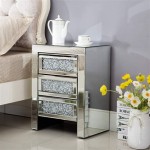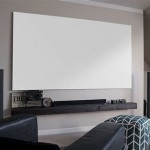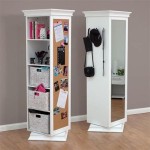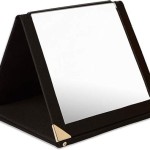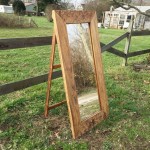How to Make a Curved Mirror Frame
Creating a frame for a curved mirror presents unique challenges compared to framing a standard rectangular mirror. The frame must follow the mirror's curve precisely for a seamless and professional finish. This article outlines the process of building a custom frame for a convex or concave mirror, offering guidance for achieving accurate measurements and a polished result.
1. Gathering Materials and Tools
Before commencing the project, assembling the necessary materials and tools is crucial for a smooth workflow. The specific materials will depend on the desired aesthetic and the mirror's dimensions.
- Flexible Wood Striping (e.g., thin plywood, bending plywood, or MDF strips)
- Measuring Tape
- Pencil
- Jigsaw or Bandsaw
- Wood Glue
- Clamps
- Sandpaper (various grits)
- Wood Finish (e.g., paint, stain, varnish)
- Safety Glasses
- Dust Mask
2. Accurately Measuring the Mirror's Curve
Precise measurement forms the foundation of a well-fitting frame. Utilizing a flexible measuring tape allows for accurately tracing the mirror's curvature. This measurement will serve as the template for cutting the frame material.
- Place the flexible measuring tape along the mirror's outer edge, conforming it to the curve.
- Note the measurement, ensuring it captures the entire curve length.
- For complex curves, consider creating a template using flexible cardboard or paper.
3. Selecting and Preparing the Wood
Choosing the right type of wood is essential for achieving the desired bend. Thinner, more flexible wood types, such as bending plywood or thin strips of hardwood, are generally preferred. The wood should be free of knots and imperfections that could compromise its flexibility and strength.
- Consider the frame's width; narrower frames require less bending and can tolerate slightly thicker wood.
- If using solid wood strips, kerfing (making shallow cuts on the back) might be necessary for tighter curves.
- Sand the wood smooth before bending to ensure a uniform finish.
4. Bending and Shaping the Wood
The process of bending the wood requires patience and precision. Applying even pressure and allowing sufficient drying time are vital for avoiding cracks or breaks. This frequently involves using clamps and a form to guide the wood into the desired shape.
- Create a form by cutting a curved shape slightly larger than the mirror's curve from sturdy material like MDF or thick plywood.
- Apply wood glue to the edges of the wood strips.
- Carefully bend the wood strip around the form, securing it with clamps.
- Allow the glue to dry completely according to the manufacturer's instructions.
5. Joining the Frame Pieces
Once the curved frame pieces are dry, they need to be joined to form a complete frame. This involves carefully aligning the edges and using a strong adhesive for a secure bond.
- Ensure the ends of the frame pieces are cleanly cut and fit together snugly.
- Apply wood glue to the joining surfaces.
- Clamp the pieces together firmly and allow the glue to dry thoroughly.
- Reinforce the joints with small brads or screws if desired, countersinking them to allow for filling and finishing.
6. Finishing the Frame
The final stage involves sanding, painting, or staining the frame to achieve the desired aesthetic. A smooth finish will enhance the frame's appearance and protect the wood.
- Sand the frame thoroughly, starting with a coarser grit and progressing to finer grits for a smooth surface.
- Apply the chosen finish, whether paint, stain, or varnish, following the manufacturer's instructions.
- Allow each coat to dry completely before applying subsequent coats.
7. Mounting the Mirror
Mounting the mirror within the frame requires careful planning and appropriate adhesives or mounting hardware. The method chosen will depend on the mirror's weight and the frame's design.
- Consider using mirror adhesive, clips, or a backing board to secure the mirror.
- Ensure the mirror is centered and securely held within the frame.
- Follow the adhesive or hardware manufacturer’s instructions for proper application.
8. Considerations for Concave vs. Convex Mirrors
Framing a concave mirror might require additional steps, as the frame will need to project outward rather than inward. Adapting the bending process and potentially adding supporting blocks or braces can accommodate this difference. Convex mirrors generally follow the process described above, as the curve bends outwards.
Building a frame for a curved mirror is a satisfying woodworking project. By following these steps and exercising patience, a custom frame that perfectly complements the mirror's unique shape can be achieved.

Round Wood Mirror Diy Angela Marie Made

How To Make A Large Arched Mirror Jenna Sue Design

Diy Oval Mirror Frame Domestically Speaking
:max_bytes(150000):strip_icc()/alahome1-a879d69e31be4a9a9ae522028c12926d.jpg?strip=all)
20 Diy Mirror Frame Ideas To Inspire Your Next Project

How To Make A Large Arched Mirror Jenna Sue Design

Upcycled Arch Mirror Using A Pool Noodle Smor Home

Build A Diy Round Mirror Frame Basic

Diy Oval Mirror Frame Domestically Speaking

Diy Window Pane Mirror Tutorial The Lettered Cottage

Diy Oval Mirror Frame Domestically Speaking


